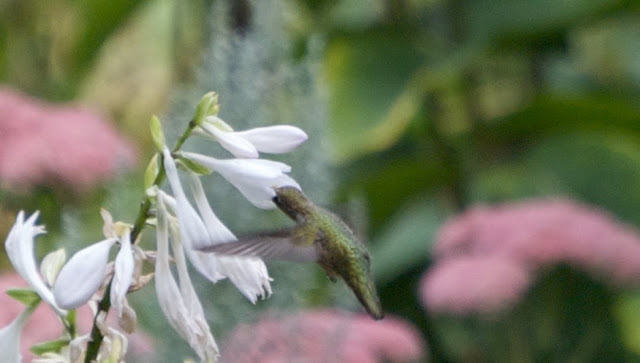Late blooming plants grace our gardens and are very beneficial to wildlife. I am sharing a few of my favorites with their wild companions. Many of these photos are from one or two weeks ago.
Hibiscus syriacus 'Rose of Sharon' is almost faded now, but a week ago many blooms were still enticing the Ruby-throated hummingbirds. The hummers left last Friday . . . perhaps as I was writing my last post mentioning they would be leaving soon. Now I see migrating birds stopping by for a quick feed, before continuing on their way. This double Hibiscus is a great feeder for hummingbirds through most of August and into September.
Thalictrum rochebruneanum 'Lavender Mist' is an airy plant also known as meadow-rue. Seven feet is about the height of this beauty in my north garden just across from the Rose of Sharon. The hummingbirds are often seen here perching. They will not find any food within the remaining blooms, for this member of the Ranunculaceae family is built without nectaries. The delicate flowers are caressed and pollinated by the wind.
Sweet scented Joe-Pye Weed stands proudly native and tall. This stately fellow reaches nearly seven feet and is named after a Native American called Jopi or Joe-pye, who knew of its medicinal qualities. Eupatorium purpureum is a member of the Asteraceae family and can also be listed under Genus: Eutrochium . . . just to confuse. This lovely plant is a division . . . a gift from my neighbor and a welcome sight for insects and people alike.
Monarchs are happy for their late flowers.
On a windy day a butterfly can lose balance high up in the flower bracts.
A bit lower to the ground . . . standing about three feet, when not flopping over . . . Sedum 'Autumn Joy' is just that to butterflies and bees. Fresh Monarchs and wild honeybees fine them irresistible.
Honeybees do get lost in their sipping frenzy in this landscape of florets . . . losing all sense of propriety.
Hosta Honey Bells or Royal Standard is still ringing her last bells and the hummers . . .
go in for her chimes.
'Miss Canada' is truly not a late bloomer . . . more an early bloomer out of season, that will be a nectar treat to migrating hummingbirds. Newly emerging butterflies will get a late spring sweet sip they will not normally have in near early fall. It is the oddest thing . . . how a plant or shrub decides to send out one last bloom . . . a beacon for wildlife.
Whatever her reasons Lilac 'Miss Canada' is feeding my soul too. There will be a long wait through winter, for her other blooms to exhale into spring air. Just as I was writing this text, I noted a hummer in the hostas and knew it would find the lilac . . . so I to the window went and sure enough . . . I will have a photo to show you soon.
Impatiens glandulifera Royal is a fave of the hummingbirds and blooms well into fall, making it a great source of nectar for migrating hummers. Also called 'Policeman's helmet' it is considered 'detrimental' as each seed pod will let loose up to eight hundred seeds. It can reach up to six feet offering hundreds of orchid like flowers in varying rose pink tones. It does not do too well in drought conditions. I will be lucky to get many plants next year.
Hummingbirds love the nectar deep inside the dangling blooms.
Ironweed . . . Vernonia altissima grew secretly from tossed seeds collected from our food co-op. Her bright purple sang out to me one day and I was puzzled until remembering loosely planting the seeds between clumps of iris. She will look lovely along side Joe-pye and offer late nectar to migrating Monarchs and other butterflies. Another member of the Aster family and a lovely addition to the middle meadow garden, where she may tower up to ten feet with iron strong stems. A beautiful native plant with many medicinal properties. I would like to think that the nectar too offers different properties from plant to plant enriching the lives of the visitors. Diversity in diet is a plus.
Young seedlings did not last a full June day, for the rabbits decided Verbena bonariensis . . . were great to chew . . . though some were able to make a comeback. Fifty of these lovelies were planted near Joe-pye Weed and Rudbeckia Herbstonne, for I knew butterflies were keen to sip and sit upon the 'purpletop'. Rabbits!!
What do they know or care of plans . . . of how the Verbena would complement the stature of these two late bloomers and feed countless Fritillaries and Aphrodites up until frost.
Salvia was spared in the terrace garden . . . it seems rabbits do not find it so delectable as this hummer clearly does. This little fellow has departed . . . he will be missed. Flower Hill Farm was his world for his beginning life and I hope he will return next spring having had many adventures under his wings and iridescent green.
Weigela florida 'The Ghost' is contributing a few late flowers for the hummers. Her foliage turns a pale yellow green late summer making the red flowers more striking reaching out from the ghostly leaves. She loves full sun and will grow to about five feet tall.
Buddleia never disappoints on her promise of continuos blooms.
A Great Spangled Fritillary enjoys dipping into the long purple tubes.




















































































































































